Using the New 6GHz Spectrum for Wireless Video Transmission with Bolt 6
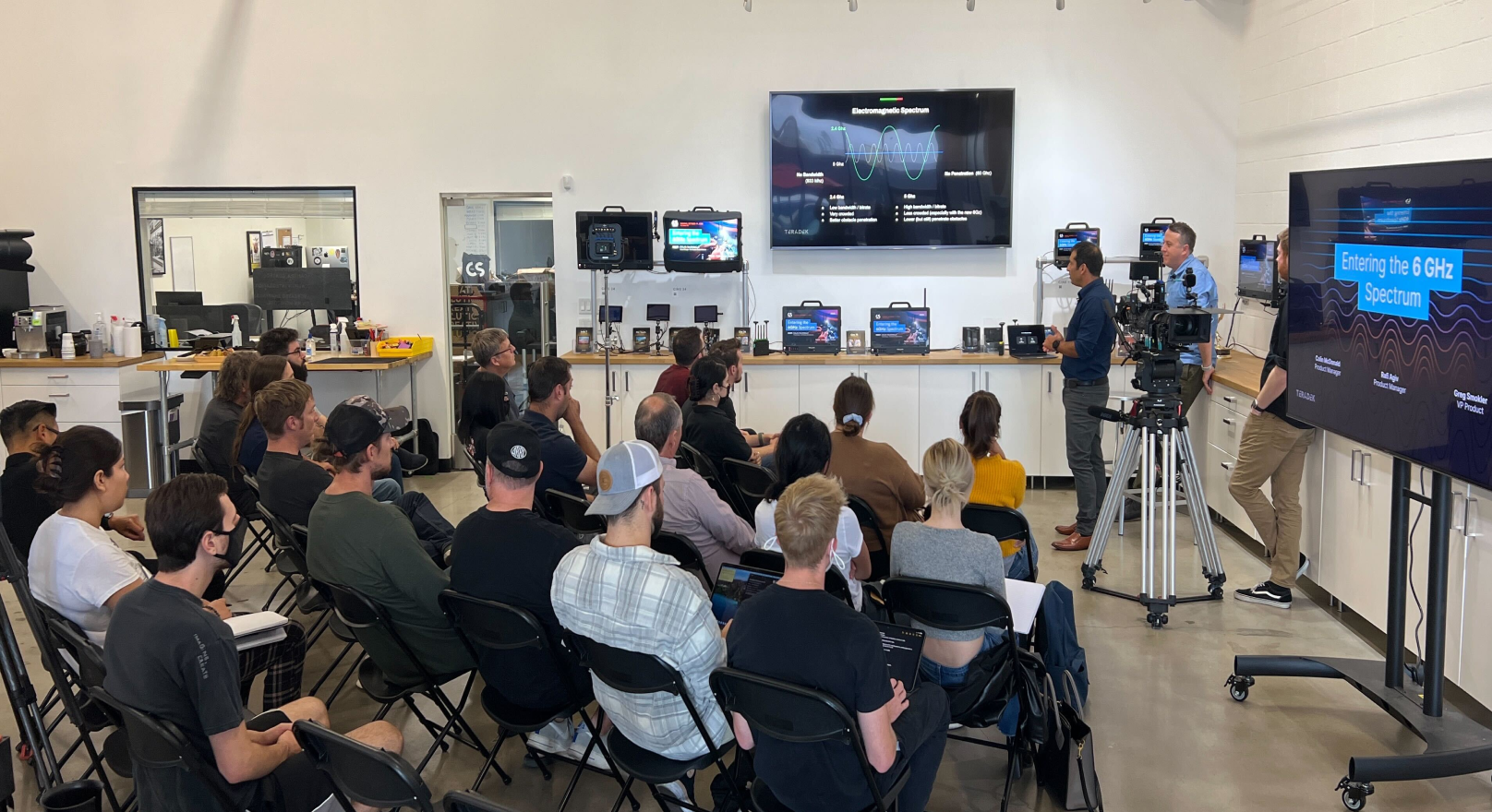
Teradek has become the first in the industry to utilize the new 6GHz spectrum for zero-delay 4K HDR wireless video transmission on set. In our CS Presents class, we explained the science of RF technology, the new wireless spectrum opened by the FCC, and how Teradek Bolt 6 utilizes Amimon’s chipset and system to give filmmakers the best gear available. We also provided a practical checklist and best practices for optimized wireless performance. Watch the video or read below to learn directly from Creative Solutions’ VP of Product Greg Smokler, Teradek’s Product Manager Colin McDonald, and Amimon’s Product Manager Rafi Agiv.
A Crowded Wireless Environment
A Crowded Wireless Environment
On set, there are a multitude of competing wireless signals that contribute to less than ideal wireless video transmission, such as the location’s WiFi, wireless audio, wireless lens control, camera control, mobile devices, radar, lighting/wireless DMX (digital multiplex), police/emergency response, and more. Amimon has developed new technologies to make sure your wireless video rises above the noise.
How does wireless technology work?
How does wireless technology work?
In the electromagnetic spectrum, we commonly use the 2.4GHz and 5GHz bands to wirelessly transmit signals so you can use the internet on your phone, ask Alexa to turn off the lights, and much more. If you were to use lower bands such as 933MHz, the signal would not have enough bandwidth. As an example, you wouldn’t be able to watch a live football game clearly. If you were to use higher bands such as 60GHz, the signal would not have enough penetration, therefore you wouldn’t be able to use your laptop in a separate room, far from the router.
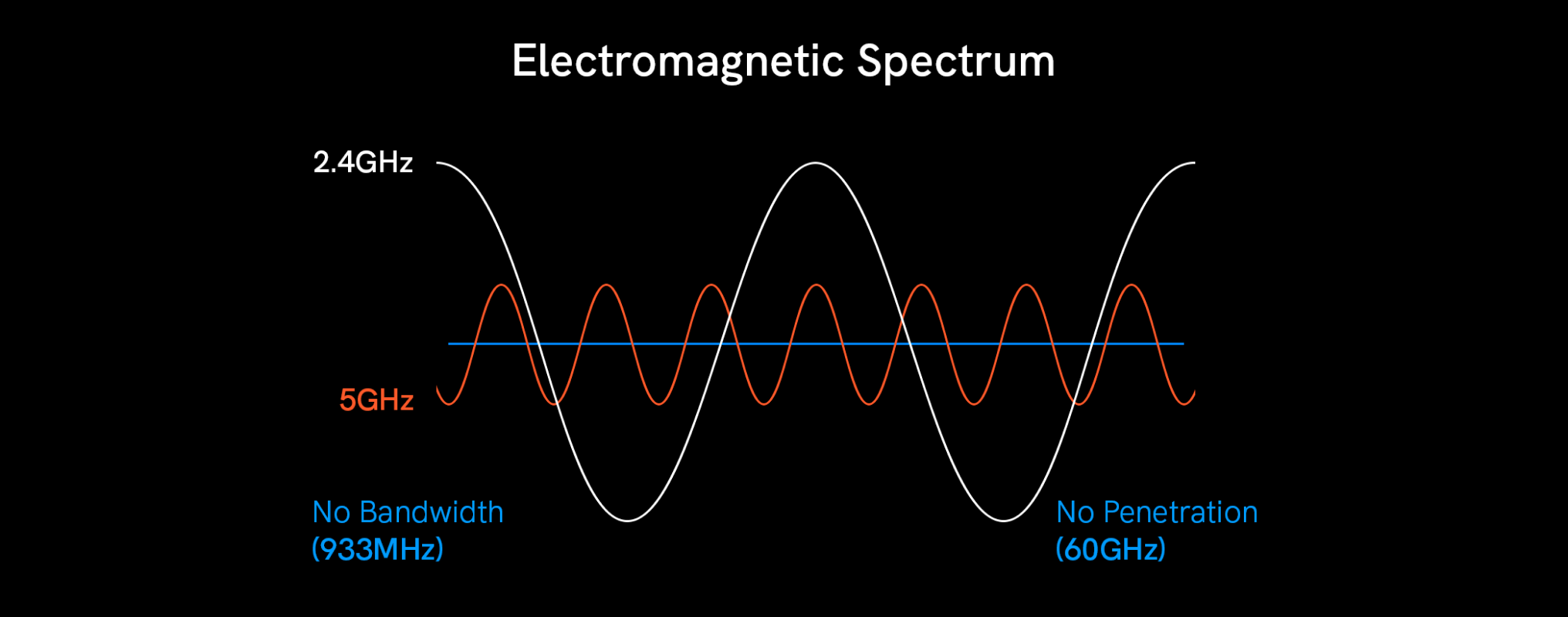
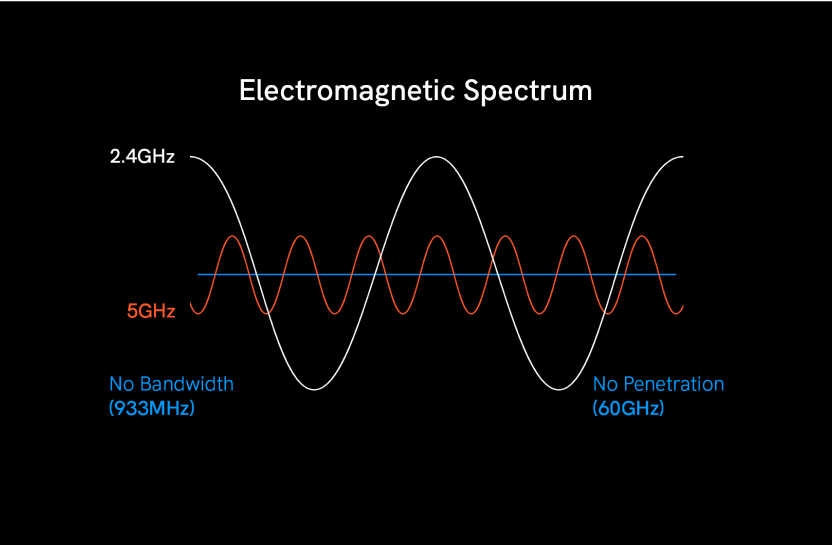
2.4GHz versus 5GHz
2.4GHz versus 5GHz
When using technology on 2.4GHz, you get low bandwidth/bitrate and less channel availability. Most devices use 2.4GHz, therefore it’s a more crowded environment. One benefit of 2.4GHz is better signal penetration through obstacles such as walls or metal. With 5GHz, you get high bandwidth/bitrate, and the signal environment is less crowded. 5GHz has slightly lower obstacle penetration but it is still very functional. You receive a very robust and stable signal indoors and outdoors, which is why Amimon utilizes 5GHz for Bolt technology.
2.4GHz
- Low bandwidth/bitrate
- Very crowded
- Better ability to move through obstacles
5GHz
- High bandwidth/bitrate
- Less crowded
Slightly lower ability to move through obstacles
How does wireless video transmission on set work?
How does wireless video transmission on set work?
On set, wireless video is transmitted in two possible ways: WiFi which is packet-based (where video is encoded then streamed over WiFi in packets), or Amimon which is frame-based (making it more suitable for film productions). To understand what “frame-based” means, we need to cover some background first.
In the transmitter, the video encoder transforms pixels into bits, then streams it. The receiver is the mirror of this process, in which the video decoder transforms bits into pixels. In order to be stable, the transmission rate (R) needs to be less than the channel capacity (C). The challenge is that the capacity always changes. For example, when someone walks through the path of transmission, or if the antennas are misplaced, the channel capacity will decrease. Amimon uses varying wireless capacity to make sure R < C.
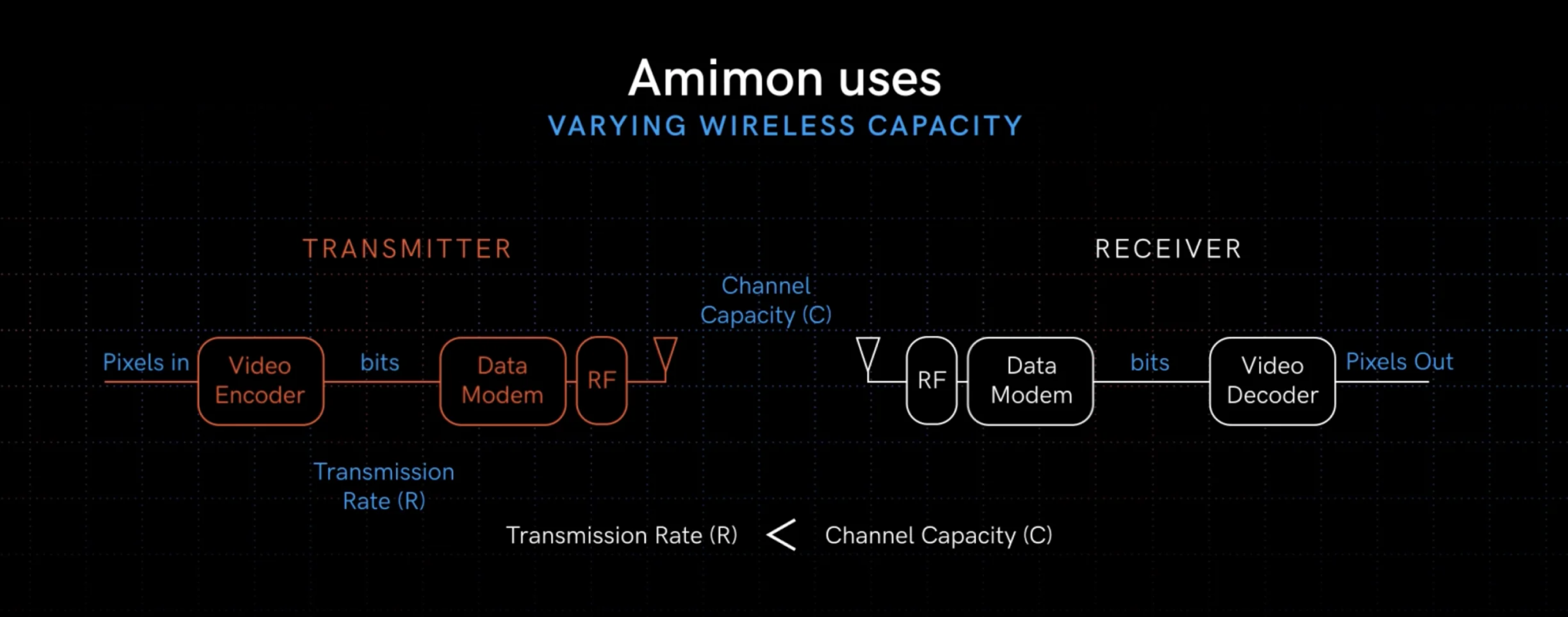
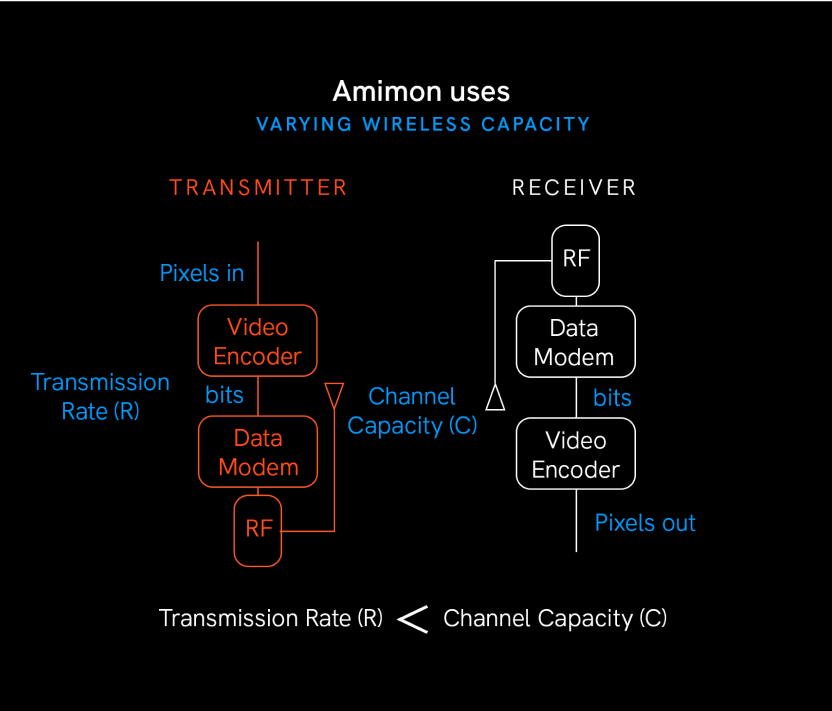
Conventional wireless video systems operate at a capacity far below the maximum, to ensure stable signals. As you might guess, you are then limited in bitrate and how much data you can send. To use more capacity, traditional systems add large buffers, which adds significant latency or drops video.
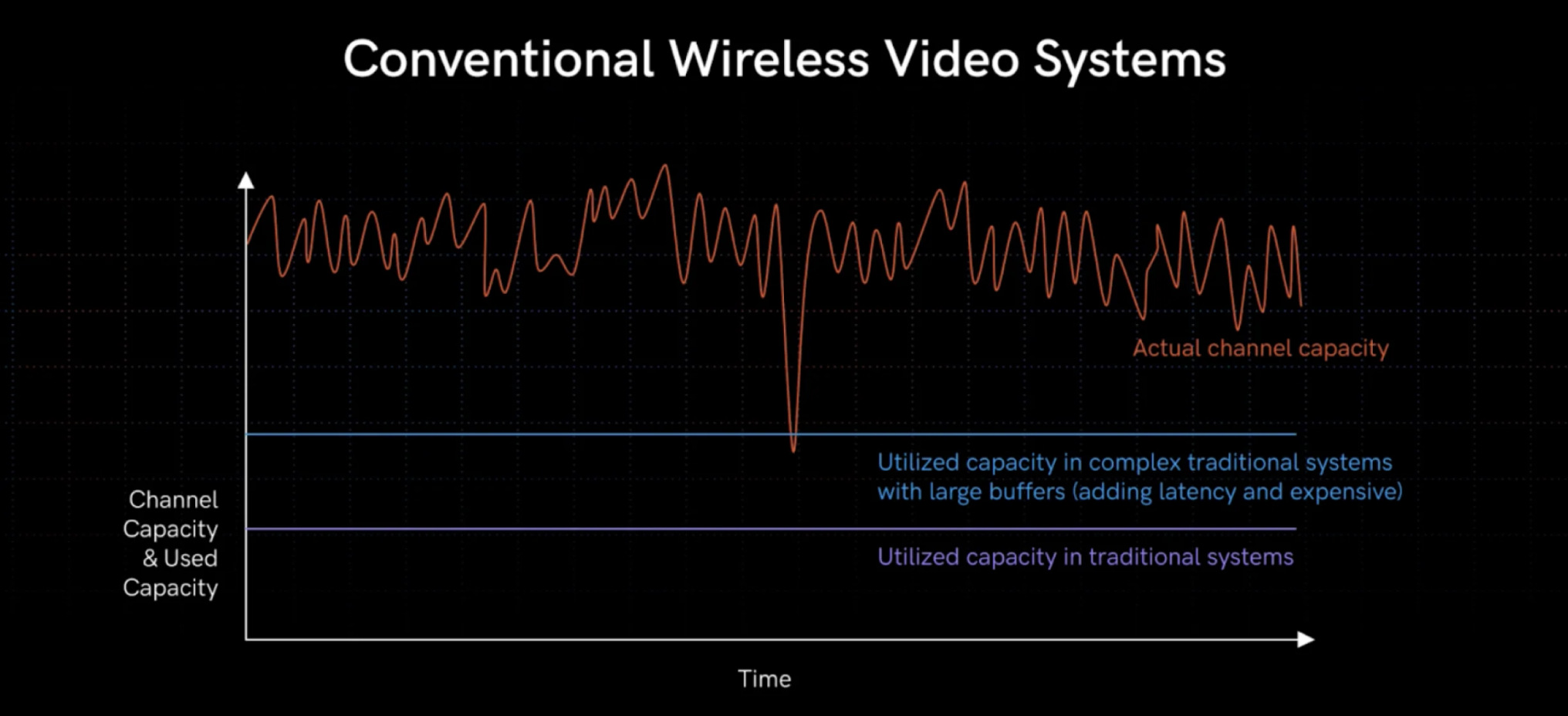
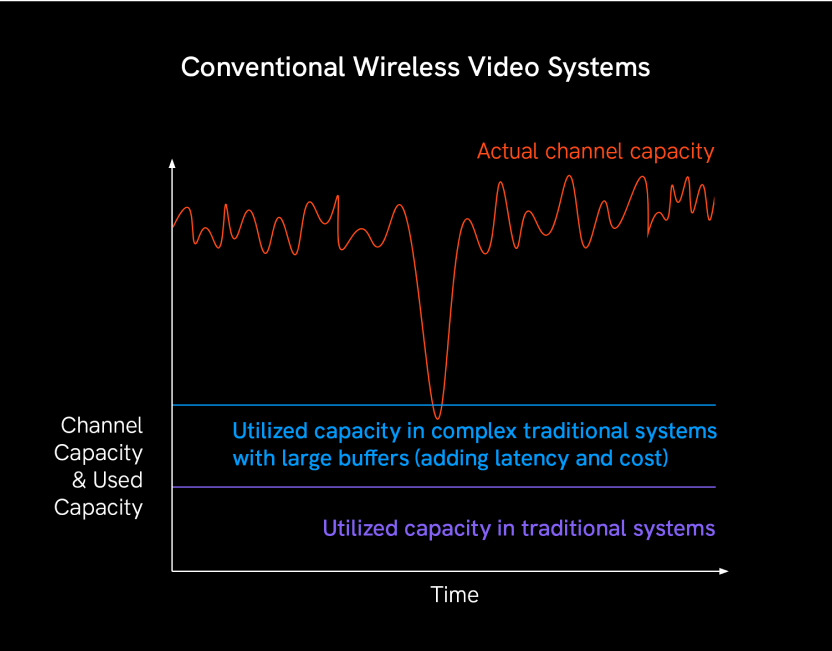
Traditional video encoders compress video frames and send them as network packets. At the receiver side, a decoder stores those packets and decodes them to be output as video frames. In order to maintain smooth video, most decoders will store multiple packets or decoded frames in a buffer before outputting them. This buffer allows the system to catch up if network variability causes packets to arrive late. Because the buffer is storing some amount of video before outputting, it adds delay in the transmission. Users will increase the buffer to avoid drops in video, but this increased buffer, or delay, becomes unfit for film production.
How does Amimon provide zero-delay transmission?
How does Amimon provide zero-delay transmission?
The Amimon system uses the entire channel capacity that is available, which removes the need for a buffer. The Amimon chipset bypasses buffers and low capacities through a unique technology called joint source channel coding.
Joint source channel coding splits the data in layers.
- Basic layer: sends completely secured audio and control data
- Coarse layer: sends most significant video information—what visually matters the most, with stronger protection.
This coarse layer is not affected by any drops in capacity. - Fine layer: sends every last byte of additional information—the least significant video information
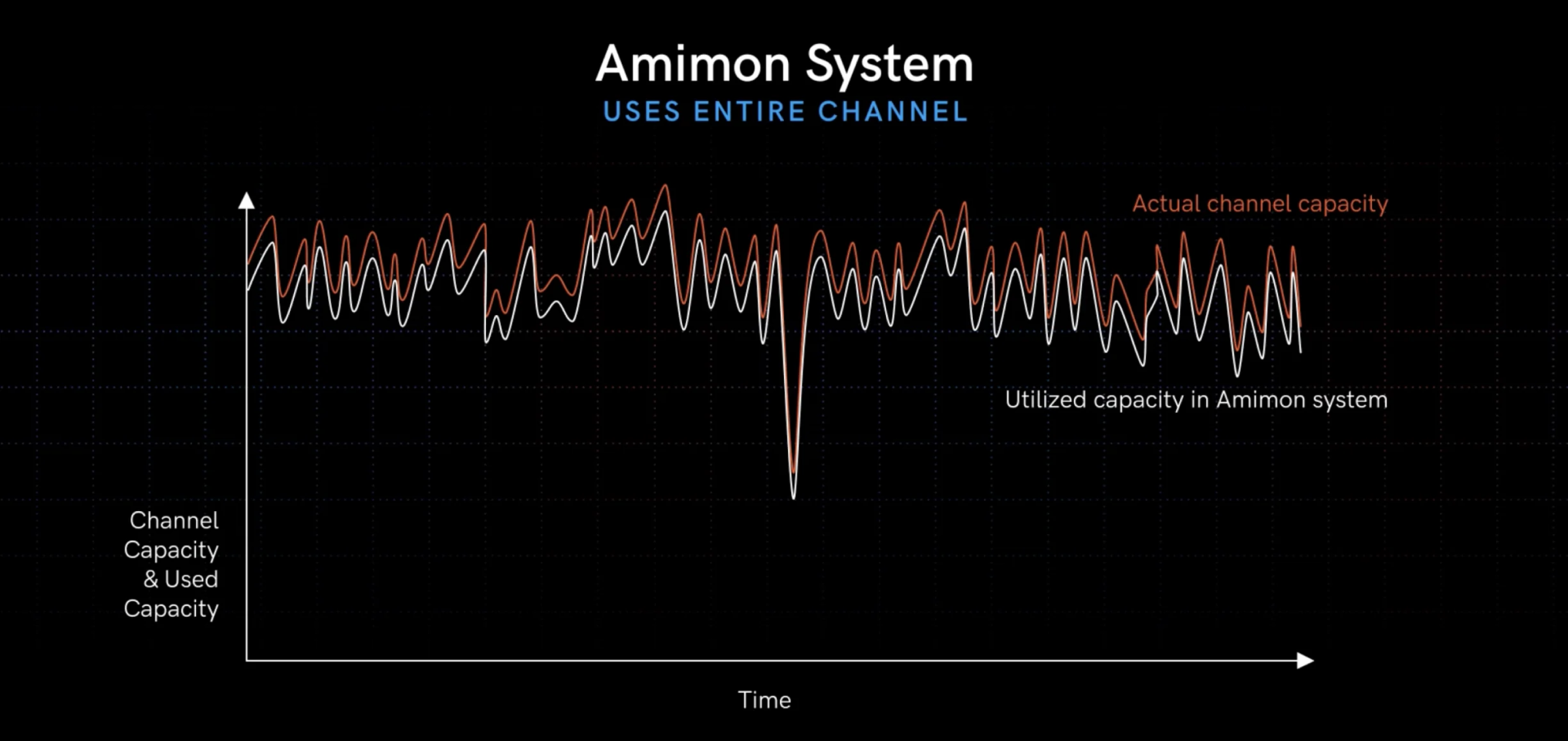
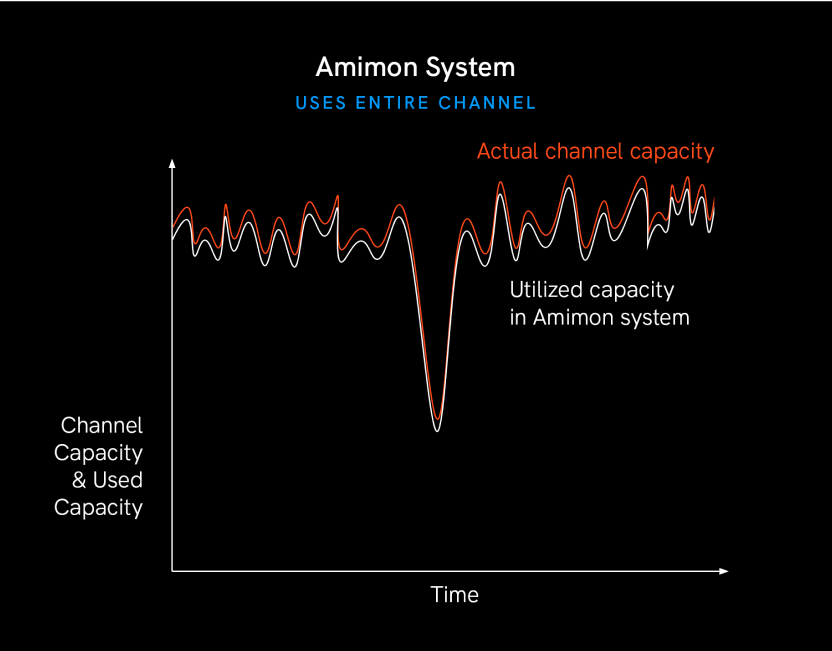
Any momentary drop in channel capacity will only affect the fine layer, as seen above in the graph. Drops will not affect latency, and it will not create a need for a buffer. The transmitter always sends everything to the receiver(s)—the basic, coarse, and fine layers—and the receivers receive the layers at their highest capacity. There is no need for the transmitter to resend frames to fill missing frames, or for the receiver to have a buffer. Each receiver, with its own channel capacity, receives as much information as is given, within its capacity. Without the need to compress or buffer video in a traditional sense, the RF channel is always fully utilized and you see pristine video with no delay.
To understand this process better, imagine the transmitter is a pianist playing on stage, and the receivers are the concert goers in the amphitheater. The transmitter/musician plays the piano passionately, and doesn’t hold back. Receiver/concert goer A is sitting in the middle, with a clear view of the stage, and they can hear and appreciate every detail of the performance. Receiver/concert goer B is stuck sitting behind a concrete pole, and they can hear the basic gist of the song but may miss the small details. Different receivers/concert goers have different capacities, and it is not the transmitter/pianist’s job to interact with each experience, only to put out the best performance possible. This technology from Amimon is truly one-of-a-kind.
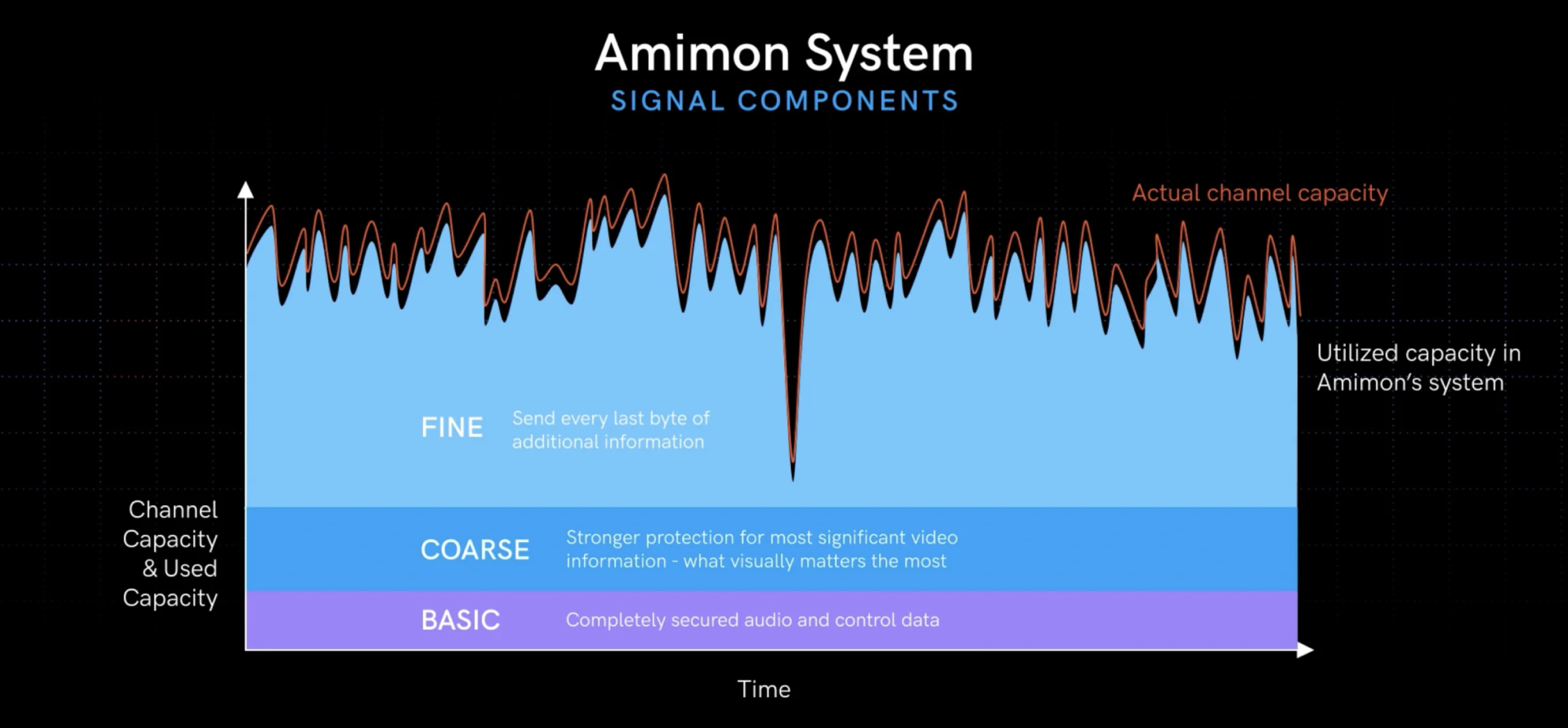
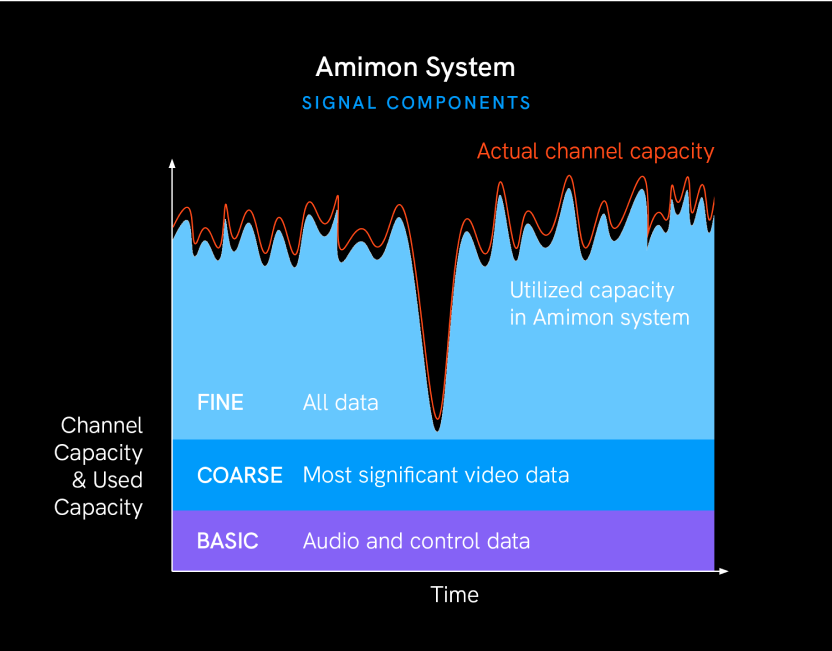
Recap
Recap
WiFi systems are packet-based, which creates:
- 2-4 frames of delay: Two frames of delay may not be noticeable on a good channel, but it poses an issue in a bad channel. On a major production where every second counts, the focus puller needs zero-delay video to accurately get every shot in focus.
- Compressed video of H.264 (AVC) or H.265 (HEVC)
- Low bandwidth
- 2.4GHz or 5GHz operability
- Less robust transmission: You will need to increase latency and buffers.
With Amimon’s frame-based system, Teradek Bolt uses the Joint Source Channel Coding Chipset, which creates:
- Zero-delay of less than 1 millisecond
- Uncompressed video, or “visually lossless” video at high bandwidth
- Patented dual modulation
- Uses 5GHz and 6GHz U-NII channels
- Fixed or dynamic frequency selection
- Very robust transmission compared to other technologies in the industry
In WiFi systems:
- Every bit is critical. Dropped packets manifest as dropped video for the end viewer.
- System needs a margin below the minimum actual channel capacity.
- Retransmission or feedback from the receiver to the transmitter is required if you want the best quality.
- On set, your video encoder sits separately from the modem. Both have to work in tandem to send the video over WiFi, which causes more chances for failure.
In Teradek Bolt and Amimon systems:
- Not all bits are equal. They are divided into basic, coarse, and fine layers.
- The Teradek receiver continuously utilizes the maximum channel capacity.
- There is no need for retransmission or feedback from the receiver to the transmitter.
- Bolt has a video encoder and modem all built in the chipset. It is designed to provide a seamless link that is dedicated to video transmission. Conversely, WiFi systems are built for networks, and can’t always handle the robustness needed for video transmission.
Word of Warning
Word of Warning
Be careful with illegal knockoffs that claim to be zero-delay at a fraction of the price. These knockoffs are not regulated—they operate beyond maximum power levels, which pose health hazards. They also operate illegally on DFS frequencies, and they infringe on our patented technology.
What is DFS?
What is DFS?
Dynamic frequency selection (DFS) is regulated internationally so that wireless technologies can cooperate across industries. DFS means that the technology scans and “checks” the frequency before using it. If for example, the specific frequency is being used by air traffic or government radar systems, that frequency cannot be overridden or used by a film production. The technology then scans other frequencies, and therefore dynamically selects a frequency based on what is available. The majority of the 5GHz spectrum is governed by DFS, so to legally use the spectrum, your technology must be certified and behave in this automatic, or dynamic, way. Operating without certification and dynamic selection (like the illegal knockoffs do) can cause enormous fines because of its disruption on an international level. At Teradek and Amimon, we always design with strong adherence to regulations for the best experience possible.
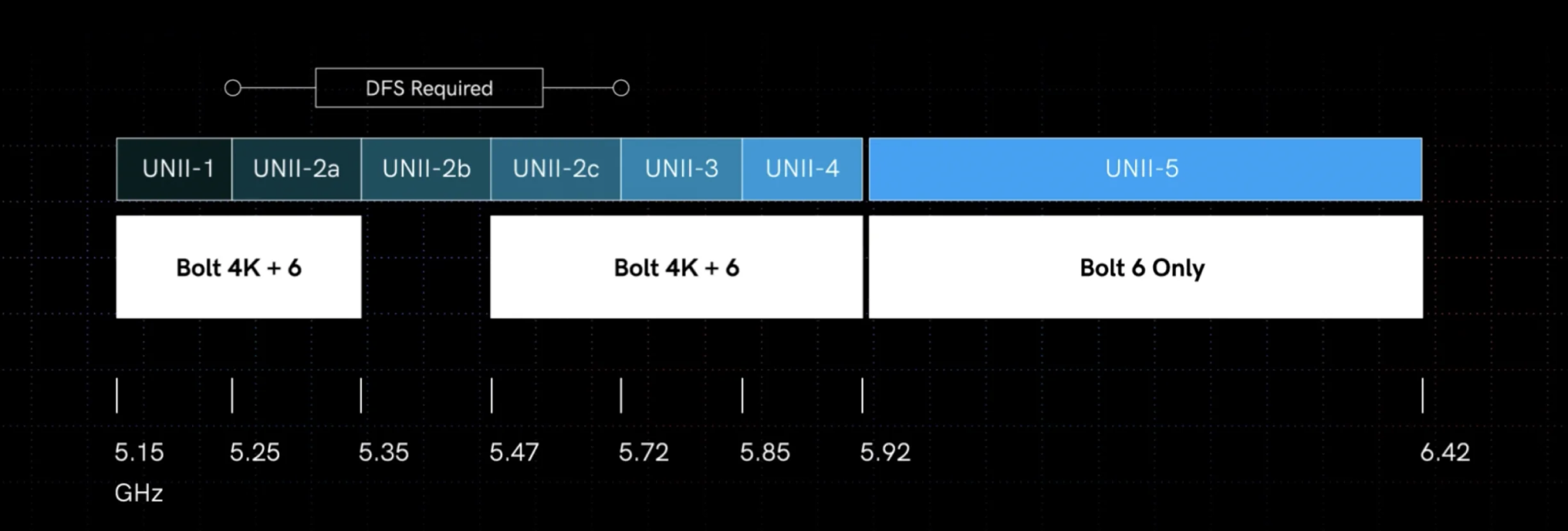
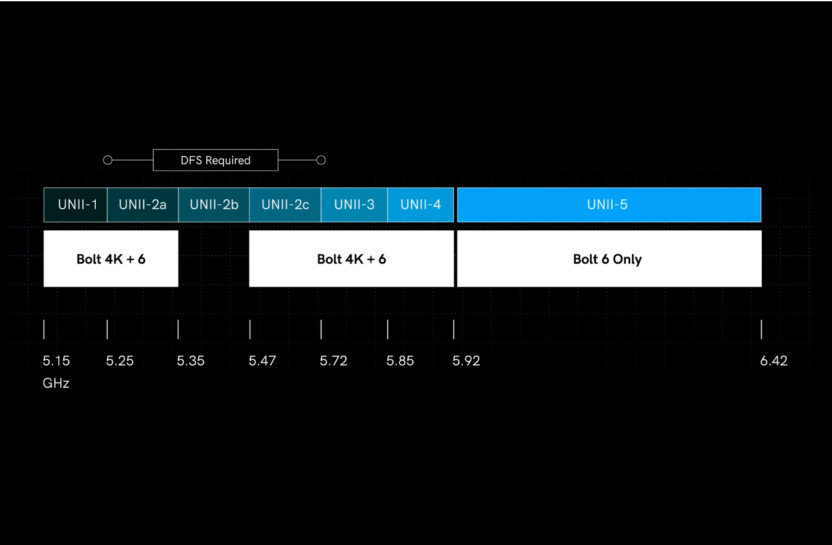
What is RF?
What is RF?
Radio frequency (RF) is a measurement of electromagnetic radio waves, which are a natural resource of our world—it’s just mother nature, so to speak. Governments regulate all RF and set aside channels for civilian use, specifically U-NII 1 through 4. (U-NII stands for Unlicensed National Information Infrastructure.) This small range of unlicensed bands is available for anyone to use. Your everyday devices have Bluetooth and WiFi and they all use these unlicensed bands. Each individual doesn’t need to sign up for a government-issued permit to connect to WiFi because the device itself is using unlicensed bands.
Up until now, U-NII 1 through 4 were available for use. With more and more wireless technology being used, these U-NII 1 through 4 frequencies have become congested with competing signals. Fortunately, the Federal Communications Commission (FCC) has recently released U-NII 5 for commercial use, the new range from 5.92 to 6.42GHz, which increases the available RF environment.
Using 5GHz versus 6GHz
Using 5GHz versus 6GHz
With lighting, production, video assist, and sound departments all using their own networks on set, the 5GHz channels become crowded. 6GHz increases the playing field.
One of the benefits of using 5GHz is that it provides a longer/more robust range than 6GHz, due to how electromagnetic waves travel. 6GHz has less interference, and the range is still strong.
We expect to see productions using a mix of 5GHz and 6GHz—using 6GHz for zero-delay wireless video transmission and using 5GHz for WiFi and more, therefore providing every department with more signal clarity.
6GHz channels are available for use in the USA, Canada, EU, and UK. Legal usage in other regions may become available soon. See this article for updated information.
Teradek Bolt—A Smarter System
Teradek Bolt—A Smarter System
Teradek Bolt offers unique features that power your workflow with ease.
- Automatic Frequency Selection: adapts to changes in interference
- Dynamic Frequency Selection: changes frequencies, according to laws and regulations
- Active Image Monitoring: video-aware channel management
Bolt 6 is the newest, most advanced wireless video transmission yet, becoming the first in the industry to utilize the new 6GHz frequencies to reduce signal congestion. To suit different workflows and builds, we offer Bolt 6 XT, Bolt 6 LT, and Bolt 6 Monitor Modules, which are all fully cross-compatible with each other. Bolt 6 is also compatible with Bolt 4K, but you will need Bolt 6s on both the TX and RX side to utilize the new 6GHz feature. We also developed an improved “long range” mode for better image quality as well as a new SDI eye pattern tool, allowing users to check SDI cable integrity on the Bolt 6 unit or Bolt Manager App.
With new frequencies comes new antennas. Access the 6GHz channels using the required 4.9-7.3GHz antennas. Use a combination of H and V antennas to increase signal diversity in all directions, and use the Array Antenna to funnel the signal into a single direction, increasing the likelihood of a strong connection (learn more about using Bolt antennas here). To better suit creative builds and prevent breakage, the H antennas are now flexible and bendable.
Wireless Best Practices
Wireless Best Practices
Every production provides a new set of challenges, so we want to arm you with some best practices and checklists to help you prepare. Signs of disruption include: video blocking, signal breakup, and signal drop. To avoid these disruptions, follow this checklist.
Wireless Best Practice #1
Wireless Best Practice #1
Clear a Path
Avoid:
- Saturation from many devices located close by
- Physical interference/mounting, obstructions in line of sight (LOS)
- Improperly designed devices a. Knockoffs are frequency polluters—they overpower the RF environment with bad frequency responses.
- Environmental factors
a. Humidity - Electromagnetic/harmonic interference
a. Poorly shielded electronics
b. Broken BNC cables. The new SDI eye pattern tool allows you to check if you have a broken or poor quality cable, and locate the source of the issue faster.
Wireless Best Practice #2
Wireless Best Practice #2
Optimize Device Location
- Position the RX above other devices
- Minimize obstructions between the TX and the RX, especially people, trees, water, etc. Line of sight is ideal. Wireless tends to perform better in a room where ceilings and walls reflect the signal. When you are outdoors, be mindful of trees and water, which absorb the signal.
- Position antennas vertically (see image below)
- Separate from other devices
- Consider using the Teradek Array antenna, a directional antenna that focuses the signal reception. Think of it like cupping your ear to better hear a sound.
- Use Teradek antennas. We have designed our antennas to perform best with our gear. The “stubby” antennas are not always tuned to operate on the proper frequencies and thus lack the flexibility, range, and quality required for fast-paced production.
Learn more about using Bolt antennas here.
Wireless Best Practice #3
Wireless Best Practice #3
Manage Your Channels
- Use a spectrum analyzer. Use the Bolt Manager App to see which frequencies have the least interference
- Use 6GHz and 5GHz. Minimize interference with 6GHz, and maximize range with 5GHz.
- Change the bandwidth. 40MHz provides a wider pipeline, by bonding two channels together
Wireless Best Practice #4
Wireless Best Practice #4
Change to Fixed Frequency Mode
In the Bolt Manager App, go to Settings to toggle on fixed frequency, which allows you to manually select a channel based on the quietest frequency in the spectrum analyzer.
Wireless Best Practice #5
Wireless Best Practice #5
Adjust Image Quality
Manually adjust settings in the Bolt Manager App to better suit your needs. Choose between:
- Auto
- Longer Distance (Normal Quality): best for outside use
- Best Quality (Mid Range): best for inside use
- Best Quality (Short Range): best for inside use
- Low Power: best for short distances of 6ft or less. For example, when a director uses a director’s monitor while standing right next to the camera, the higher power settings can overwhelm the system at such a short distance.
Final Thoughts
Final Thoughts
Teradek has become the first in the industry to utilize the new 6GHz spectrum for zero-delay 4K HDR wireless video transmission on set. In our CS Presents class, we explained the science of RF technology, the new wireless spectrum opened by the FCC, and how Teradek Bolt 6 utilizes Amimon’s chipset and system to give filmmakers the best gear available.
This information and video was courtesy of your friends at Teradek and Creative Solutions Los Angeles. As we work towards engaging and educating our community, we will continue to hold classes at our CSLA showroom highlighting various topics.
If you are interested in signing up for alerts on upcoming classes, please sign up for event updates from us or our sister companies, SmallHD and Wooden Camera.
Sign Up for
Updates on
our
Newest Products
Sign Up for
Updates on
our
Newest Products




